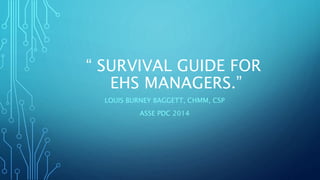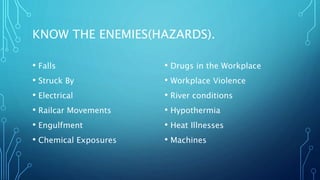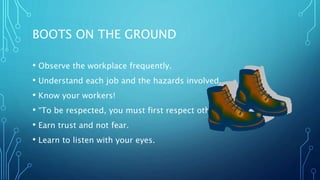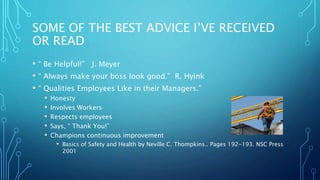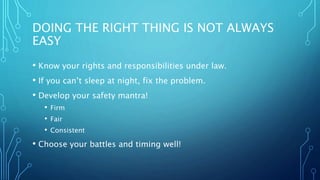Survival Guide for
- 1. “ SURVIVAL GUIDE FOR EHS MANAGERS.” LOUIS BURNEY BAGGETT, CHMM, CSP ASSE PDC 2014
- 2. MY EHS WORLD • Marine Cargo Terminal • Rail yard • Warehousing • Truck & Train Loading • Chemical Safety • HR Responsibilities • Security OSHA EPA DO T FRA DO L USCG
- 3. SURVIVAL (DEPT. OF THE ARMY FIELD MANUAL) • Size up the situation • Undue haste makes waste • Remember where you are • Vanquish fear and panic • Improvise • Value living • Act like the natives • Live by your wits, but for now Learn Basic Skills
- 4. KNOW THE ENEMIES(HAZARDS). • Falls • Struck By • Electrical • Railcar Movements • Engulfment • Chemical Exposures • Drugs in the Workplace • Workplace Violence • River conditions • Hypothermia • Heat Illnesses • Machines
- 5. THE BEGINNING OF EHS SURVIVAL • Good hiring practices. • Background checks and references. • Interviews • Physicals and drug testing. • 30-90 Day Probationary Periods. • Train supervisors to mentor new hires. • New Hire Training (Company and OSHA Specific).
- 6. BOOTS ON THE GROUND • Observe the workplace frequently. • Understand each job and the hazards involved. • Know your workers! • “To be respected, you must first respect others.” • Earn trust and not fear. • Learn to listen with your eyes.
- 7. SOME OF THE BEST ADVICE I’VE RECEIVED OR READ • “ Be Helpful!” J. Meyer • “ Always make your boss look good.” R. Hyink • “ Qualities Employees Like in their Managers.” • Honesty • Involves Workers • Respects employees • Says, “ Thank You!” • Champions continuous improvement • Basics of Safety and Health by Neville C. Thompkins.. Pages 192-193. NSC Press 2001
- 8. THE HARDEST THINGS I’VE HAD TO DO. • Trips to the Emergency Room with injured workers. • Facing hostile employees. • Expert witness in wrongful death cases. • Corporate witness for silicosis and other respiratory cases. • Facing OSHA in Contested Cases. • Firing workers for drug abuse or unsafe practices.
- 9. DOING THE RIGHT THING IS NOT ALWAYS EASY • Know your rights and responsibilities under law. • If you can’t sleep at night, fix the problem. • Develop your safety mantra! • Firm • Fair • Consistent • Choose your battles and timing well!
- 10. BUILD CREDIBILITY IN YOUR FIELD • Certified Safety Professional • Certified Hazardous Materials Manager • OSHA Outreach Trainer • National Safety Council Trainer • Community Emergency Response Team • Mentor the young people walking in your footsteps!
- 11. STAY CONNECTED • American Society of Safety Engineers • American Industrial Hygiene Association • National Safety Council • Gateway Society of Hazardous Materials Managers • St. Louis University School of Public Health • Safety Council of Greater St. Louis
- 12. SURVIVAL KIT EHS • Have a kit • Get training • Have a plan • Practice FIRST AID
- 13. YOUR KIT • Regulatory expertise • Human psychology • “Do unto workers, as you would have them do unto you.” • Certification as a professional. • Practice your Code of Ethics. • Never quit learning!
- 14. TACTICAL SAFETY • Definition: • “ of, relating to, or used for a specific plan that is created to achieve a particular goal in war, politics, etc.” Merriam-Webster • “ adroit in planning or maneuvering to accomplish a purpose.” Merriam- Webster • Practical in that it works and is not merely theoretical.
- 15. TACTICS OF SAFETY MANAGEMENT • Understand the hazards of the workplace. • Understand your workers(troops). • Educate to their level of ability and comprehension. • Practice according to a planned curriculum. • Sharpen their skill levels by constant training and reinforcement. • Mean what you say, but don’t be mean in saying it. • Defeat injuries and illnesses before they defeat you!
- 17. 17 MASTER THE TRIANGLE Safe Conditions & Behaviors Risk Taking Incident First Aid & Doctor Cases D.A.R.T. Disability Death Costs Civil, Criminal, Tort Liabilities. Long-term Costs Worker Comp Costs Medical Costs Physical Damage Unsafe Behaviors Maximum Profit , Performance OSHA, NIOSH, NFPA, NEC, AIHA, EPA, DOT
- 18. SURVIVE AND THRIVE THROUGH EHS • Protecting workers, communities, businesses and the environment. • Professional associations and friendships. • Prepare the future leaders for a safer world. • Practical and tactical from start to finish. • Prepare to WIN!
- 19. BOOKS ARE YOUR FRIENDS • Basics of Safety and Health. Neville C. Tompkins. National Safety Council. • Safety Made Easy. A Checklist Approach to OSHA Compliance. John R. Grubbs and Sean M. Nelson. Government Institutes. www.govinstpress.com.
